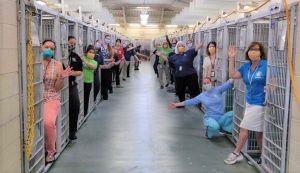Module 7: Get to Know a Shelter
Can Shelters Start Back with a New Normal? The Human Animal Support Services Model
Faced with social distancing (increasingly referred to as physical distancing) requirements, animal shelters replaced some of their routine face-to-face encounters with virtual ones. One of the most dramatic transitions was converting the pet adoption process to a curbside or totally online experience. Shelters have long posted their pet profiles online, but now adopters spend more time narrowing down the list in a process akin to a dating app. This matchmaking process has been remarkably successful, with no greater rate of adoptions that don’t work out than with traditional meet and greets.
Shelters Empty Out and Flip to Virtual Adoptions

Florida Animal Shelter Celebrates Emptying a Kennel for the First Time Ever
By David Williams and Amanda Jackson
A Florida kennel that’s normally packed with stray and abandoned dogs was filled instead with cheering staff and volunteers because all of the animals have found new homes.
Friends of Palm Beach County Animal Care and Control shared video of the moment on social media this week and said it’s the first time the shelter has emptied one of its three kennels. This video contains applause only, no dialogue.
The kennel has 48 dog runs that often hold two dogs each, according to Elizabeth Harfmann, the community outreach manager for the shelter.
“It’s definitely been a combined effort from the community. The animals went to foster homes, adopters and to our partner rescue organizations,” Harfmann told CNN. “We’ve also seen a decrease in incoming animals, so that has helped as well.”
Many shelters across the nation are seeing a surge in adoption applications from people who have more time to devote to a new pet, since they’re staying at home to slow the spread of the coronavirus pandemic. Read more . . .

I Video Chatted with a Cat and Now She’s Mine
By Marie Solis
“Should we Zoom?” I texted Valerie one Thursday evening, around 6 p.m.
“I think FaceTime works better,” she wrote back. “In case she’s on the move.”
A few minutes later, I answered my phone, and a small brown tabby cat appeared on the screen. After we exchanged hellos, Valerie, the cat’s foster mom, introduced the two of us: Ava was a playful and affectionate seven-month-old who didn’t get along with the resident cat in Valerie’s apartment. She had big, bright green eyes, a white smudge on the bridge of her nose, and a fluffy tail, like a raccoon. Read more . . .
Kristen Hassen-Auerbach, director of Pima Animal Care Center in Tucson, Arizona, of one the largest open-admission shelters in the country, observed that the COVID-19 pandemic forced an overnight transformation of animal sheltering from a focus on institutionalizing large numbers of animals in a central facility to helping keep families together and calling upon the community to open their homes to animals while permanent solutions could be identified.
“In considering what a different future for homeless pets might look like, we know that ultimately, we must de-institutionalize the work of caring for lost and temporarily homeless pets, create a distributed model of animal social services to serve pets in the neighborhoods where they live, with the ultimate goal of keeping the vast majority of pets home or very close to home. Serious thought and planning around implementing this model would have seemed insurmountable, if not impossible, prior to the emergence of COVID-19. The emergence of this disease, tragically spread through much of the world has profoundly disrupted life and the status quo for many institutions, including animal services.
Over the past five weeks, shelters have had to change their entire operating structures, at lightning speed, shelters have discarded many of the old systems, in an attempt to keep people safe. Shelters have done away with barriers to placement, punitive policies, and discontinued the use of available kennel space to house any pet for any reason. In just a few days, many shelters emptied their kennels, sent most pets to live in foster homes. In addition, they suspended all but the essential intake, embracing a new pilot model that slows or stops the constant flow of animals into the institution. They asked their communities to take collective responsibility for stray and homeless pets, holding pets in homes to avoid bringing them to the shelter. In this one moment, when so much uncertainty, sadness, and fear exists in the world, there is a glimmer of hope for what animal sheltering will be if we let go, once and for all, of the broken pound model.
The solution will require a new ethic for the care of companion animals in our communities. Learning lessons from human child welfare, education, social work, and human services, we will rebuild with the premise that animal services’ primary functions are to maintain, support, and strengthen the bonds between people and pets.”
Human Animal Support Services: The Future of Serving Pets and People in Our Communities
Goal: Build an animal services system that treats the shelter institution as a pet crisis response center, emergency room and place owners can come for pet support services. Create a distributed network model of pet social services to reduce the need for shelters to unnecessarily house pets who are better served by remaining in the community, in their homes or in foster homes.
Objectives:
- Reduce the number of pets physically entering the shelter by 50% or more
- Reduce the number of pets housed in the shelter by 50% at all times
- 80% success rate of pet retention efforts for owners facing barriers to keeping their pets
- House 50% of pets in foster at any given time
- Provide outcome pathway for 80% of pets entering the shelter system within 72 hours of arrival, reducing in-shelter length of stay to three days for most pets
- Reallocate 25% or more of total budget to providing pet support, returning lost pets home, pet retention services, self-rehoming support, and intake-to-placement programs
- Accommodates budget reductions necessary due to COVID-19 impacts
- Increase volunteer programs by 200% or more, creating a new range of volunteer functions operating outside the walls of the shelter
As communities begin to open up, animal shelters have an opportunity to change their model from an institutional approach that separates animals from their people, to a case-management approach that seeks to keep families together, blending the best of One Health, animal welfare, and human social services.
Want to Learn More?
COVID resources for animal shelters and veterinarians:
- National Animal Control Association: Guidance Statements for Animal Control Agencies
- American Pets Alive: COVID-19 Animal Shelter Preparedness Guide
- American Veterinary Medical Association (AVMA): What Veterinarians Need to Know
- Centers for Disease Control and Prevention: Pets and Other Animals
- Worms and Germs Blog: COVID Topics
- Maddie’s Shelter Medicine Program at UF: COVID -19 Guidance and Webcasts

